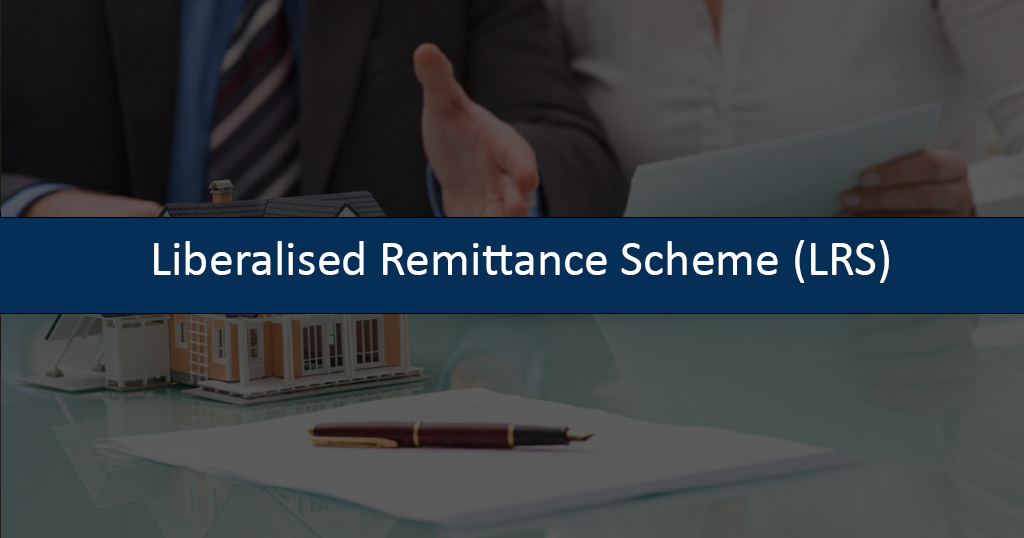Liberalised Remittance Scheme (LRS)

Liberalised Remittance Scheme (LRS)
The Liberalized Remittance Scheme (LRS) is a scheme introduced by the Reserve Bank of India (RBI) that allows resident individuals in India to remit a certain amount of money abroad for various purposes without seeking prior approval from the RBI. The LRS aims to facilitate resident individuals to diversify their investment portfolio and engage in international financial transactions.
The LRS can be used for a variety of purposes, including travel, education, medical treatment, gifts, maintenance of relatives abroad, and investment in stocks and real estate outside India.
Under the Liberalised Remittance Scheme, all resident individuals, including minors, are allowed to freely remit up to USD 2,50,000 /- per financial year (April – March) for any permissible current or capital account transaction or a combination of both. Further, resident individuals can avail of foreign exchange facility for the purposes mentioned in Para 1 of Schedule III of FEM (CAT) Amendment Rules 2015, dated May 26, 2015, within the limit of USD 2,50,000 only.
Purposes under FEM (CAT) Amendment Rules, 2015, under which a resident individual can avail of foreign exchange facility:
Individuals can avail of foreign exchange facility for the following purposes within the LRS limit of USD 2,50,000 on financial year basis:
- Private visits to any country (except Nepal and Bhutan)
- Gift or donation
- Going abroad for employment
- Emigration
- Maintenance of close relatives abroad
- Travel for business, or attending a conference or specialised training or for meeting expenses for meeting medical expenses, or check-up abroad, or for accompanying as attendant to a patient going abroad for medical treatment/ check-up
- Expenses in connection with medical treatment abroad
- Studies abroad
- Any other current account transaction which is not covered under the definition of current account in FEMA 1999.
The AD bank may undertake the remittance transaction without RBI’s permission for all residual current account transactions which are not prohibited/ restricted transactions under Schedule I, II or III of FEM (CAT) Rules, 2000, as amended or are defined in FEMA 1999. It is for the AD to satisfy themselves about the genuineness of the transaction, as hitherto.
However, for the purposes i.e., Emigration, Expenses in connection with medical treatment abroad & Studies abroad, the individual may avail of exchange facility for an amount in excess of the limit prescribed under the Liberalised Remittance Scheme as provided in regulation 4 to FEMA Notification 1/2000-RB, dated the 3rd May, 2000 (here in after referred to as the said Liberalised Remittance Scheme) if it is so required by a country of emigration, medical institute offering treatment or the university, respectively:
LRS scheme for NRIs
The LRS scheme applies to the residents of India, and thus, the remittance takes place through a savings account. Non-Residential Indians are not supposed to have any savings accounts in Indian banks. Thus, they cannot remit funds from India, but they are permitted to transfer funds from NRO, NRE, and FCNR accounts abroad as per the regulations and requisite documentation:
- They are permitted to transfer up to USD 10,000 from an NRO account.
- No limitations apply to payments made from an NRE or FCNR account.
- The Liberalised Remittance Scheme has made it simpler for Indian citizens to manage financial transactions abroad.
- You can use the funds for debt repayment, education, and other needs. You can also invest outside of India, which is a great method of diversifying your investment portfolio.
Tax on Liberalised Remittance Scheme (LRS)
| LRS- Remittance for | TCS rate with effect from 01.10.2023 | ||
|---|---|---|---|
| Exemption Limit | Rate | ||
| a) Education abroad If the amount being remitted out is a loan obtained from any approved financial institution. | 7 Lakhs | 0.5% | |
| b) Education abroad if the remittance is out of own funds and not out of loans as mentioned in (a) above | 7 Lakhs | 0.5% | |
| c) Medical treatment | 7 Lakhs | 5% | |
| d) Any other such as gift, emigration, family maintenance, investments etc | 7 Lakhs | 20% | |
| e) Purchase of overseas tour program package | Nil | 5% till Rs. 7 lakhs. 20% Above Rs. 7 lakhs. |
# 1/3rd reduced for Land value.
Form 15CA and Form 15CB
Conditions under New GST Rate for the Builders:
- Form 15CA and 15CB which does not require RBI approval will NOT be required to be furnished by an individual for remittance.
- List of payments of specified nature mentioned in Rule 37BB, which do not require submission of Forms 15CA and 15CB, has been expanded from 28 to 33 including payments for imports.
- Form No.15CB will only be required for payments made to non-residents, which are taxable and if the payment exceeds Rs.5 lakh.
A person responsible for making a payment to a non-resident or to a foreign company has to
provide the following details:
When payment made is below Rs 5 lakh: For such payments information is required to
be submitted in Part A of Form 15CA
When payment made exceeds Rs 5 lakh:
Following documents is required to be submitted:
- Part B of Form 15CA has to be provided
- Certificate in Form 15CB from an accountant
- Part C of Form 15CA
When the payment made is not chargeable to tax under IT Act: Part D of Form 15CA is required to be submitted.
In the following cases, no submission of information is required:
- The remittance is made by an individual and it does not require prior approval of Reserve Bank of India [as per the provisions of section 5 of the Foreign Exchange Management Act, 1999 (42 of 1999) read with Schedule III to the Foreign Exchange (Current Account Transaction) Rules, 2000] T
- The remittance is of the nature specified in the list below:
Overall list of payments where no forms 15CA and 15CB are required are as follows (Rule 37BB):
| S.No | Nature of Payment |
|---|---|
| 1 | Indian investment abroad -in equity capital (shares) |
| 2 | Indian investment abroad -in debt securities |
| 3 | Indian investment abroad-in branches and wholly owned subsidiaries |
| 4 | Indian investment abroad -in subsidiaries and associates |
| 5 | Indian investment abroad -in real estate |
| 6 | Loans extended to Non-Residents |
| 7 | Advance payment against imports |
| 8 | Payment towards imports-settlement of invoice |
| 9 | Imports by diplomatic missions |
| 10 | Intermediary trade |
| 11 | Imports below Rs.5,00,000-(For use by ECD offices) |
| 12 | Payment- for operating expenses of Indian shipping companies operating abroad. |
| 13 | Operating expenses of Indian Airlines companies operating abroad |
| 14 | Booking of passages abroad -Airlines companies |
| 15 | Remittance towards business travel. |
| 16 | Travel under basic travel quota (BTQ) |
| 17 | Travel for pilgrimage |
| 18 | Travel for medical treatment |
| 19 | Travel for education (including fees, hostel expenses etc.) |
| 20 | Postal Services |
| 21 | Construction of projects abroad by Indian companies including import of goods at project site |
| 22 | Freight insurance – relating to import and export of goods |
| 23 | Payments for maintenance of offices abroad |
| 24 | Maintenance of Indian embassies abroad |
| 25 | Remittances by foreign embassies in India |
| 26 | Remittance by non-residents towards family maintenance and savings |
| 27 | Remittance towards personal gifts and donations |
| 28 | Remittance towards donations to religious and charitable institutions abroad |
| 29 | Remittance towards grants and donations to other Governments and charitable institutions established by the Governments. |
| 30 | Contributions or donations by the Government to international institutions |
| 31 | Remittance towards payment or refund of taxes. |
| 32 | Refunds or rebates or reduction in invoice value on account of exports |
| 33 | Payments by residents for international bidding. |
Parts of Form 15CA
Part A
To be filled irrespective of whether taxable or not and the remittance or its aggregate does not exceed Rs. 5 lakh in a financial year.
Part B
To be filled when the Certificate under Section 195(2)/195 (3)/197 of the Income Tax Act has been obtained from the Assessing Officer.
Part C
To be filled when the remittance or its aggregate exceeds Rs. 5 lakh in a financial year and that remittance is chargeable to tax.
Part D
Is filled when as per the domestic laws, the remittance is not chargeable to tax.
Illustrations:
1. Arjun wants to get his heart surgery done at United Kingdom. Up to what limit Foreign Exchange can be drawn by him and what are the approvals required?
2. Mr. Rana, an Indian Resident individual desires to obtain Foreign Exchange for the following purposes:
(A) US$ 120,000 for studies abroad on the basis of estimates given by the foreign university.
(B) Gift Remittance amounting US$ 10,000.
Whether he can get Foreign Exchange and if so, under what condition(s)?
Remittance of Foreign Exchange for studies abroad: Foreign exchange may be released for studies abroad up to a limit of US $ 250,000 for the studies abroad without any permission from the RBI. Above this limit, RBI’s prior approval is required. Further proviso to Para I of Schedule III states that individual may be allowed remittances exceeding USD 250,000 based on the estimate received from the institution abroad. In this case since US $ 120,000 is the drawal of foreign exchange, so permission of the RBI is not required.
Gift remittance exceeding US $ 10,000: Under the provisions of Section 5 of FEMA 1999, certain Rules have been made for drawal of foreign exchange for current account transactions. Gift remittance is a current account transaction. Gift remittance exceeding US $ 250,000 can be made after obtaining prior approval of the RBI. In the present case, since the amount to be gifted by an individual, Mr. Rana is USD 10,000, there is no need for any permission from the RBI.





